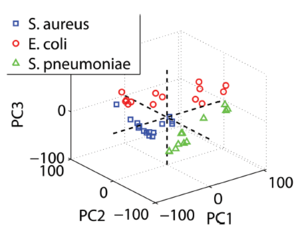Rapid identification of bacteria in blood cultures by mass-spectrometric analysis of volatiles
C. Ballabio, S. Cristoni, G. Puccio, M. Kohler, M. R. Sala, P. Brambilla, P. M-L Sinues
Abstract: Blood cultures are routine tests to determine whether micro-organisms have entered the patient’s bloodstream. Automated systems, based on the detection of CO2 increase in the culture media, have considerably improved the screening efficiency for the detection of bacteria. However, further identification of bacteria still requires time consuming culturing procedures.
It has been suggested that along with CO2, bacterial cultures emit characteristic volatile organic compounds that may be valuable for characterisation. Recently, a number of technological developments have allowed the detection of trace gases with minimal or no sample preconcentration steps. In the current study, we investigated whether the volatiles emitted from bacterial cultures (mimicking routine clinical blood cultures) could be distinguished from each other in a rapid fashion by secondary electrospray ionization-mass spectrometry (SESI-MS).


